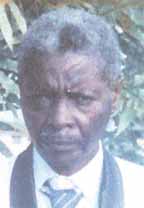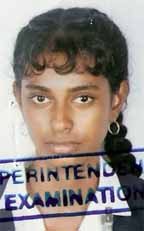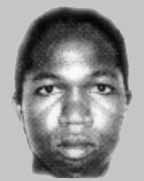In just two months, four murder cases have been thrown out of court and the accused set free owing to sloppy police investigation and weak evidence gathering.

The latest case was the 2004 Dairy Bar murder.
After clinging to hope that the justice system would sway in their favour, the relatives of security guard Noel Jones grieved a second time after the accused was set free last Thursday.
Jones’ daughter Barbara told Stabroek News recently that they may have lost to man but God is in charge and one day they will get the justice they deserve.
The woman said Seon Yaw was positively identified by a grey patch above his eye but it was sloppy policing, a weak prosecution and a strong defence counsel that ensured that he was set free.
“This thing didn’t come as a shock to me and I know that he [Yaw] was part of the group responsible for the death of my father,” the still grieving woman said. The woman said the three perpetrators of the armed robbery at Dairy Bar were captured on security footage. Relatives had clung to hope since Yaw was the only surviving suspect. The other two had been killed by police on separate occasions, Barbara said.
The woman said she attended court last Thursday for the case but did not want to be in court for the verdict because deep down she knew Yaw was going to be a free man. She recalled that she left to go downstairs and on her return, she heard the judge telling the accused that when he sees a crowd he should move away and should educate himself. Minutes later she heard the words “you are free to go”.
“This thing ain’t come as no surprise to me because from the beginning I was hearing that he will be freed,” she said shaking her head.

She partially blamed the court for the outcome of the case, stressing that a weak prosecutor was appointed to fight a strong lawyer.
Because so much time had elapsed – almost six years, the main witness, Barbara said could not remember all that she had said in the lower court and at times was trapped by the defence lawyer during questioning.
“The police investigation was so poor. They were so dunce. They didn’t even have pictures of the dead body. They claimed that the film was destroyed,” she said adding that she believed that it was the mindset of the ranks that made the case fall apart.
“It was negligence and laziness on their part. They feel that the man done dead and that’s it,” she added.
The woman expressed the opinion that this is the general attitude of the ranks in the force and results in either sloppy or incomplete investigation.
Justice William Ramlal who presided over the case had blasted the police over their poor investigative work. While stressing that he was not attacking the entire force, Justice Ramlal pointed out that the investigators in this particular case displayed what can be described as “pure incompetence and nothing else”. Further, he said this is a problem that is serious and needs to be urgently addressed.
Stabroek News was unable to reach senior police officials and the Director of Public Prosecutions (DPP) Shalimar Ali-Hack for comments on this particular case.
Dairy Bar
Barbara recalled that the elderly Jones had been ill for two weeks and had to return to work at Dairy Bar on Croal Street on December 4, 2004. The woman said one could tell that he hadn’t recovered fully from his illness and she pleaded with her mother to let him remain at home. She recalled her mother telling her that he had to go and she watched him walk up the road until he was out of sight. Hours later, around midnight, she said, her nephew informed her that Jones had been taken to the hospital. Barbara said she was under the impression that he had collapsed at work but it was only later as they were about to leave the area, that she was told that her father had been shot and killed during a robbery.

Reports then had said that Jones was a security guard on duty at the Original Dairy Bar on Croal Street when three armed bandits stormed the fast food establishment and robbed it of $132,000. The 73-year-old died from a single gunshot wound to his upper chest after being forced into a toilet.
Raped and murdered
Teenager Roshanie Pertab Singh was raped and murdered in June 2006, but the alleged perpetrator was freed last Thursday, at the Preliminary Inquiry (PI) stage after two hostile witnesses changed their stories.
Seenarine Ramnarine who was charged with the brutal murder Singh of Number 19 Village, East Coast Berbice walked out of the Albion Magistrate’s Court a free man.
According to the facts of the charge, between June 6 and 7, 2006, Ramnarine raped and murdered Singh, who was also a Sunday school teacher and was at the time in the process of writing her Caribbean Secondary Education Certificate (CSEC) exams. Singh, who was a student of the Berbice Educational Institute at the time, would usually sleep at the house where the incident occurred, as a companion to Budia (only name), the then 73-year-old woman who resided there. Reports are that Singh had been asleep in the house and was later found with her throat slashed, her underwear down to her ankles and cuts about her private parts.
During the PI two witnesses were taken into custody after giving conflicting evidence. Narindai Gobin also of Number 19 during her testimony from the witness box changed her story from what she had told the police in her statement after the incident.
Budia after giving the police a statement on what had happened that night, said in her evidence in chief from the witness box that she could not remember anything and did not know what happened. After repeated efforts by the prosecution to get her to say what she could remember failed, she was deemed a hostile witness and was arrested.
Weak ID evidence
Six years after being accused of murdering a man in Buxton in 2004, Trion `Latie’ Sumner and Quincie `Killer’ Mc Lennon were freed on May 12 after weak identification evidence was submitted to the court.
The main witness Errol Adams who testified to being with the deceased on January 9, when the incident occurred, made conflicting statements during his testimony.
At the police station Adams told a policeman that he had been attacked by five men and that he knew them. Later, when asked during court proceedings to identify the accused, Adams could not tell the court which was the number one accused and which was the number two.
The policeman who took Adams’ report that day told the court that he only had the descriptions of the attackers and no names. However, he later told the court that he had no description and no names. How the police managed to arrest the accused is a mystery.
The presiding judge, Justice Roxane George, had said that there was no identification parade during which either Sumner or Mc Lennon was identified, there was no general description of either accused given by the witness in court; as a result dock identification was not carried out. Police, Justice George had said, provided no evidence to identify either Sumner or Mc Lennon.
These points all show that poor investigation was done by police, Justice George said. She further told the jury that the state counsel did the best job she could at prosecuting the case using the materials provided to her.
Justice George told the jury that they should not develop any opinion since they must enter the courtroom free of prejudice.
The prosecutor, she said, presents a good case when there is enough evidence. If there is no evidence or not enough evidence to prove an accused guilty beyond a reasonable doubt then this is no fault of the prosecutor.
‘Sweeter leg’
On May 14, Hafeez Khan, who had been accused of murdering his friend Anthony ‘Pumpkin’ Waldron, was found not guilty.
During a ruling in which he upheld no-case submissions by the defence, Justice Ramlal stated that the prosecution’s case was “very weak and tenuous” before directing the jury to return a not guilty verdict in the trial.
He added that there was no direct evidence implicating Khan in the murder and pointed out that the prosecution led circumstantial evidence.
Justice Ramlal opined that the police did not do a good job in investigating the case and later pointed out that the shortcomings were not the fault of the prosecution.
The police did not get a fingerprint from the scissors which was established to be the murder weapon, the judge noted. Khan had also allegedly confessed in a caution statement to police but it was later established that the statement had been taken contrary to the laws and could not be entered as evidence.
It had been alleged that on February 22, 2004 Khan murdered Waldron at Vreed-en-Hoop, West Coast Demerara. The deceased, Khan, Omar Singh and Rondon Lyte were at the house of a friend, Joycelyn Willis. The group had been consuming alcohol all night before the incident and continued doing so until the time when the incident reportedly occurred.
While drinking, an argument about who had “the sweeter leg” erupted between Khan and Waldron. Lyte testified that Khan then left the group and went to Willis’ kitchen, returned with a knife and started “fanning it” in Waldron’s face. Willis was immediately informed of what was happening and took the knife from Khan. Lyte subsequently left the men and went to use the latrine. He spent five to 10 minutes in the latrine and while returning to the house he saw Khan and Waldron “fighting.” However, by the time he got to the kitchen the men were no longer there (in the kitchen). Lyte subsequently discovered Khan outside the house holding Waldron.
